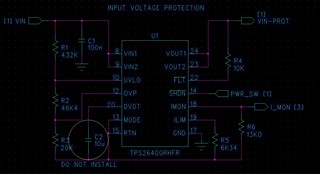Other Parts Discussed in Thread: LM60440
Tool/software:
Hi,
We have implemented the TPS2640 (VQFN package) in a design, however, the reverse polarity protection does not work. The other protection features seem to be functioning properly, and I don't measure a short circuit between RTN and GND which the datasheet says will disable the reverse polarity protection. Is there any other way that it might be disabled? From what I can tell our implementation is almost identical to the evaluation circuit.

Pins 1-7, 11, 16, and 21 are unconnected. Pin 25 (Pad) is connected to RTN.
PWR_SW goes to a connector and the external switch eventually connects the net to system ground.
I_MON connects to a GPIO on a PIC32 microcontroller.
I considered that these external connections might somehow be influencing the chip, but I built up the eFuse circuit on a bare board without anything else and saw the same behavior.
Thanks,
Kyle.


